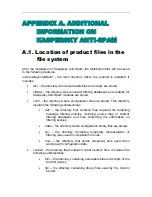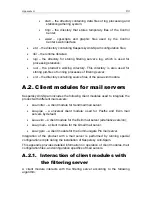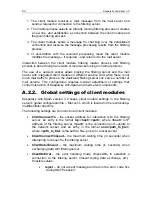
Appendix A
87
and the rules defined for the
managers
group state that all messages
with
Not Detected
status should be accepted. As a result, the mail
message with
[!! SPAM]
tag in the subject line is delivered to the both
recipients. The message contains the following headers:
X-Spamtest-Status-Extended: SPAM
X-Spamtest-Status-Extended: Not detected
X-Spamtest-Group-ID: 00000002
X-Spamtest-Group-ID: 00000001
Which indicate that the message was processed in accordance with the
rules defined for groups with identifiers 1 and 2 (identifiers of
sales
and
managers
groups), and the message was assigned
SPAM
and
Not Detected
statuses. For detailed information on the headers, see the
item A.5 on page 112.
•
If the message is addressed to several recipients and delivery is
prohibited for some of them (
reject message
action selected), and for
others is allowed (
accept message
action selected), then the bounce
message is not sent to the individual recipients;
•
Since there is no way to limit the number of simultaneous connections to
the port 25 in Sendmail, then the number of running
ap-mailfilter
filtering
processes depends on the number of incoming connections, which can
cause additional server load.
A.2.4.
kas-pipe
– a client module for the
Postfix and Exim mail servers
The
kas-pipe
module is a universal client module of Kaspersky Anti-Spam and it
can be used for integration with any of the supported mail servers.
In the default installation,
kas-pipe
is used for integration with Postfix and Exim.
The
kas-pipe
module accepts mail, and returns it to the mail server after filtering
through the SMTP or LMTP protocols.
Execution of
kas-pipe
module is initiated by an external application (for example,
mail server). For mail transfer a network or local socket is used. Also, it is
possible to run the accepting application with the
fork
and
exec
commands.
The Figure 32 illustrates the module interaction scheme when Kaspersky Anti-
Spam is used with
kas-pipe
.
















































